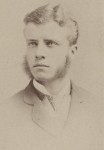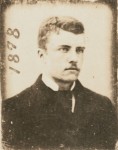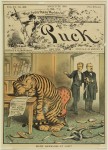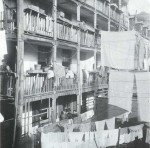 Today would be Theodore Roosevelt’s 155th birthday. In honor of the 26th president, Harvard’s Houghton and Widener Libraries have put together a slideshow of the young Teddy from childhood to his undergraduate days at Harvard College. It’s a small selection from the collection of 172 images of Roosevelt in his youth that was gifted to Harvard by the Theodore Roosevelt Association in 1943. They provide a glimpse into Roosevelt long before his grinning, bespectacled, moose-riding presence became instantly recognizable, and they’re smartly captioned with brief anecdotes and descriptions. Many thanks to the Houghton and Widener Libraries for allowing me to use high resolution versions of the photographs in this post.
Today would be Theodore Roosevelt’s 155th birthday. In honor of the 26th president, Harvard’s Houghton and Widener Libraries have put together a slideshow of the young Teddy from childhood to his undergraduate days at Harvard College. It’s a small selection from the collection of 172 images of Roosevelt in his youth that was gifted to Harvard by the Theodore Roosevelt Association in 1943. They provide a glimpse into Roosevelt long before his grinning, bespectacled, moose-riding presence became instantly recognizable, and they’re smartly captioned with brief anecdotes and descriptions. Many thanks to the Houghton and Widener Libraries for allowing me to use high resolution versions of the photographs in this post.
 He’s really quite unrecognizable, an adorable little boy and a handsome young man. His blue eyes, later hidden behind his characteristic wire-rimmed pince-nez glasses, are striking. His mutton chops are downright impressive once they get going. Of course instead of simply enjoying the growth and development of TR, I had to go falling down a couple of rabbit holes inspired by the images and captions.
He’s really quite unrecognizable, an adorable little boy and a handsome young man. His blue eyes, later hidden behind his characteristic wire-rimmed pince-nez glasses, are striking. His mutton chops are downright impressive once they get going. Of course instead of simply enjoying the growth and development of TR, I had to go falling down a couple of rabbit holes inspired by the images and captions.
 First observe a four-year-old Teddy looking like Little Lord Fauntleroy in a velvet jacket holding a fuzzy cap. Those baggy pants tied under the knee he’s wearing were known as Knickerbockers after the fictional author in Washington Irving’s 1809 Knickerbocker’s History of New York. Diedrich Knickerbocker is the descendant of 17th century Dutch immigrants who settled New York when it was New Amsterdam, and as such is a member of the highest ranks of New York society. In Irving’s book these New York Dutch aristocrats wear old-timey knee-breeches, emblems of their long heritage in the city. It was an entirely fictional depiction, but the name stuck. From then on, the Dutch-descended patricians of New York became known as Knickerbockers and so did the poofy pants. Later, New York sports teams would take on the name too.
First observe a four-year-old Teddy looking like Little Lord Fauntleroy in a velvet jacket holding a fuzzy cap. Those baggy pants tied under the knee he’s wearing were known as Knickerbockers after the fictional author in Washington Irving’s 1809 Knickerbocker’s History of New York. Diedrich Knickerbocker is the descendant of 17th century Dutch immigrants who settled New York when it was New Amsterdam, and as such is a member of the highest ranks of New York society. In Irving’s book these New York Dutch aristocrats wear old-timey knee-breeches, emblems of their long heritage in the city. It was an entirely fictional depiction, but the name stuck. From then on, the Dutch-descended patricians of New York became known as Knickerbockers and so did the poofy pants. Later, New York sports teams would take on the name too.
The Roosevelts were Knickerbockers par excellence. They were descendants of one Claes Maartenszen van Rosenvelt who settled in New Amsterdam in the 1640s and purchased 48 acres of prime farmland bounded by Lexington Avenue and Fifth Avenue between 29th St. and 35th St. Midtown Manhattan, including the lot that now hosts the Empire State Building, was the first American Roosevelt’s personal stomping ground.
 The other picture that sent me down history nerd lane was the 1878 tintype of Theodore after he shaved off his fine set of sideburns. The caption quotes a letter Teddy wrote to his sister Corinne Roosevelt Robinson on May 3rd, 1878:
The other picture that sent me down history nerd lane was the 1878 tintype of Theodore after he shaved off his fine set of sideburns. The caption quotes a letter Teddy wrote to his sister Corinne Roosevelt Robinson on May 3rd, 1878:
“At last the deed is done and I have shaved off my whiskers! The consequence, I am bound to add, is, that I look like a dissolute democrat of the fourth ward. I send you some tintypes I had taken for distribution among my family and friends. The front views are pretty good; although giving me an expression of gloomy misery that I sincerely hope is not natural. The side views do not resemble me any more than they do Michael Angelo or John A. Weeks.”
(John A. Weeks was a wealthy lawyer, real estate mogul, philanthropist and art lover. His wife was Alice Hathaway Delano, relative of Sara Delano who was the mother of Frederick Delano Roosevelt, Theodore Roosevelt’s fifth cousin.)
It was TR’s description of himself looking like “a dissolute democrat of the fourth ward” that caught my eye. It just sounds cool, first of all, and it’s a neat early glimpse into a concern that would help define Roosevelt’s political career. The Fourth Ward of New York City was a crime-ridden slum on the Lower East Side. This was full Tammany territory, the uncontested domain of corrupt bosses who could deliver votes en bloc to their pet politicians.
Tammany Hall was a Democratic Party machine and Teddy would fight it at his first opportunity. He was elected as a Republican to the New York State Assembly in November of 1881, just three years after he wrote that letter to his sister. The fact that he was a mere baby of 23 years did not deter him from focusing on his reformist agenda. In his first 48 hours of the legislative session, he introduced four reform bills (water purification, alderman election reform, finance reform and judicial reform). Only the alderman one passed and only after major changes, but TR didn’t let that slow him down. He was re-elected in 1882 and in 1884 introduced three bills aimed at kneecapping the party machines. Of the three, the Reform Charter Bill was the highest priority because it focused on increasing the power and accountability of the mayor to weaken the stranglehold of the board of aldermen which was controlled by the party machines.
 The Reform Charter Bill passed and was signed into law by Governor Grover Cleveland, a Democrat who had formed an alliance with Tammany Hall to win the election only to govern with integrity and honesty, much to Tammany’s horror. The bill became known as the Roosevelt Bill and newspapers went nuts over how Roosevelt and Cleveland were cutting Tammany down to size.
The Reform Charter Bill passed and was signed into law by Governor Grover Cleveland, a Democrat who had formed an alliance with Tammany Hall to win the election only to govern with integrity and honesty, much to Tammany’s horror. The bill became known as the Roosevelt Bill and newspapers went nuts over how Roosevelt and Cleveland were cutting Tammany down to size.
Ten years later, Theodore Roosevelt came to a whole new understanding of the Fourth Ward. In 1895, he became New York City Police Commissioner. Accompanied by reformer photojournalist Jacob Riis who had exposed the vile living conditions of the immigrant poor in the tenements of New York City’s Lower East Side in his 1890 book How The Other Half Lives, Roosevelt patrolled the poverty-stricken streets between midnight and dawn, checking up on his beat cops to be sure they were a) awake, b) sober, c) not spending all night in saloons, d) not taking bribes, inspecting tenements for compliance with health codes, deterring crime with his mere presence.
 He became such a common figure on the streets of the Lower East Side at night that he earned the outstanding nickname of Haroun al Roosevelt after the character of Harun al-Rashid in the One Thousand and One Nights. In his autobiography Riis described the two years of Roosevelt’s patrols as a Golden Age. Roosevelt called Riis “the most useful citizen of New York” for having shone a light — literally; the new invention of flash made it possible to effectively photograph the dark tenements for the first time — on the reality of life in the slums.
He became such a common figure on the streets of the Lower East Side at night that he earned the outstanding nickname of Haroun al Roosevelt after the character of Harun al-Rashid in the One Thousand and One Nights. In his autobiography Riis described the two years of Roosevelt’s patrols as a Golden Age. Roosevelt called Riis “the most useful citizen of New York” for having shone a light — literally; the new invention of flash made it possible to effectively photograph the dark tenements for the first time — on the reality of life in the slums.
In a complete coincidence, one of those Fourth Ward streets TR patrolled was Roosevelt Street. It was named after one of early Rosenvelts who owned the property in the 17th century. The street is gone now, built over in 1950 by the Alfred E. Smith Houses, a public housing development named after the former governor and candidate for president who made wet dreams come true.
I enjoyed your post on TR. To add to the birthday celebration, all are welcome to visit my website where I have photographs of the interiors of Sagamore Hill, which is TR’s Oyster Bay mansion and “Summer White House.”
The photos were commissioned by the National Park Service and a selection will be on exhibit at Harvard’s Houghton Library next year. The images present rare views of the interiors as they are mostly vacant due to a renovation. http://www.xiomaro.com/TR
only TR can pull off tights and doo rag in a photo and look like a doofus.
***NOT look like! woops! :blush:
Yay
THAT IS MY BOY!!!!!
I remember little baby Ted!